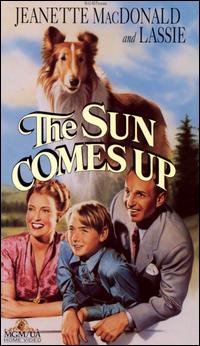| The Sun Comes Up | |
|---|---|
 VHS cover | |
| Directed by | Richard Thorpe |
| Screenplay by | Margaret Fitts William Ludwig Eric Knight |
| Based on | Mountain Prelude 1947 serial story by Marjorie Kinnan Rawlings |
| Produced by | Robert Sisk |
| Starring | Jeanette MacDonald Lloyd Nolan Claude Jarman Jr. Pal (credited as "Lassie") |
| Cinematography | Ray June |
| Edited by | Cotton Warburton |
| Music by | André Previn |
| Distributed by | Metro-Goldwyn-Mayer |
Release date |
|
Running time | 93 minutes |
| Country | United States |
| Language | English |
| Budget | $1,659,000 [1] [2] |
| Box office | $1,280,000 (Domestic earnings) [1] $764,000 (Foreign earnings) [1] |
The Sun Comes Up is a 1949 Metro-Goldwyn-Mayer Technicolor picture with Lassie. Jeanette MacDonald had been off the screen for five years until her return in Three Daring Daughters (1948), but The Sun Comes Up was to be her last. In it, she had to share the screen not with an up-and-coming younger actress but with a very popular animal star. Although her retreat from a film career can be blamed largely on an increasingly debilitating heart ailment (which eventually took her life at the age of 61 in 1965), MacDonald continued to make concert and TV appearances after this. Her last radio performance was a broadcast version of this same story on The Screen Guild Theater in March 1950. [3]